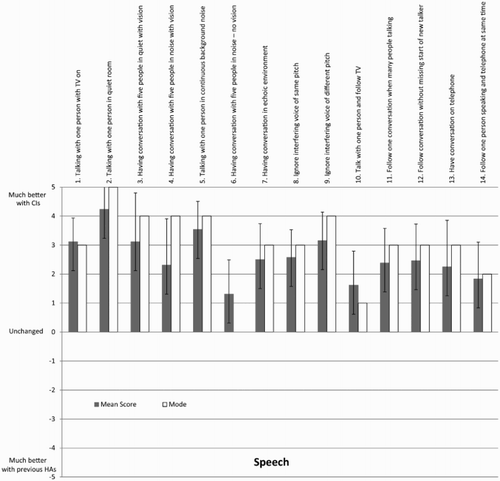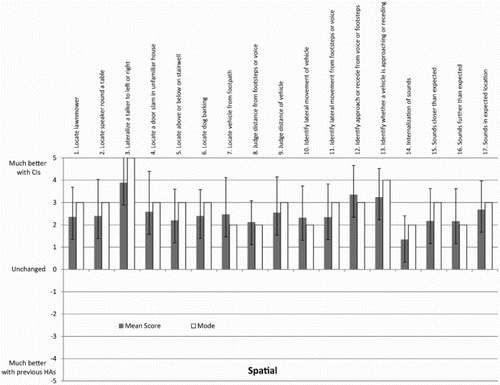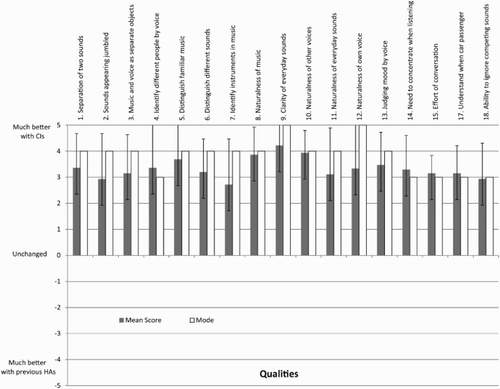Abstract
Severe to profoundly deaf adults who score 50% or over on the Bamford-Kowal-Bench (BKB) sentence test currently cannot obtain NHS funding for a cochlear implant according to the NICE guidelines (NICE Technical Appraisal Guidance (TAG166), 2009. Cochlear implants for children and adults with severe to profound deafness. NICE technology appraisal guidance [TAG166]. http://www.nice.org.uk/ta166 accessed 08/02/2016). There is no cut-off restriction from the BKB score for children. This study challenges this restrictive criteria for adults, by presenting the outcomes of cochlear implantation in older children who scored over 50% on BKB sentence testing pre-implantation and therefore would not have been implanted under the adult NICE guidelines. Outcomes are presented using the Speech, Spatial and Qualities of Hearing Scale Version C (SSQ-C) (Gatehouse, S., Noble, W. 2004. The Speech, Spatial and Qualities of Hearing Scale (SSQ). International Journal of Audiology, 43: 85–99.). This study suggests a greater proportion of adults who are currently being restricted from having a cochlear implant would benefit from implantation.
Introduction
For children under the age of 19, the NICE definition of inadequate benefit from hearing aids is judged according to whether the multi-disciplinary team considers that their speech, language, and listening skills are delayed due to their hearing loss. As such, if this criterion is assessed as met, we are able to offer implant(s) to these young people who score higher than 50% on BKB testing, and we have looked at their outcomes to challenge whether the adult criteria is too restrictive.
The RNTNE Cochlear Implant Department and St Thomas’ Hearing Implant Centre have previously presented the outcomes in older children who did not meet adult BKB speech perception criteria but who were implanted under the paediatric criteria (CitationVickers et al., 2015). This study demonstrated that post-implantation, there were improvements for these children in BKB sentence testing in quiet and in noise, Arthur Boothroyd word lists, Categories of Auditory Performance (CAP), and the Meaningful Auditory Integration Scale (MAIS). These outcome measures were not sensitive enough in some children at reflecting the improvement in performance post-implantation. Many of our subjects and their parents reported cochlear implantation as ‘life-changing’. The common themes reported included less need for repetition, increased self-confidence, incidental hearing, reduced effort for listening, and less reliance on lip-reading. This paper has aimed to capture these ‘real-world’ benefits which were difficult to reflect in our first study.
Method
Seventeen subjects were retrospectively analysed. The age at implantation ranged from 7 to 18 years old. All subjects had a sudden onset or a progressive hearing loss. All subjects were bilateral hearing aid users pre-implantation. All the subjects, except Subject 12, met the NICE criteria of severe to profound deafness, which is defined as hearing only sounds that are louder than 90 dB HL at frequencies of 2 and 4 kHz without acoustic hearing aids (see Table ). Subject 12 was an exception in that she had a threshold of 80 dB HL at 2 kHz in one ear. Of the 17 subjects, 14 were bilaterally implanted and 3 were unilaterally implanted. All subjects received cochlear implant(s) from either MED-EL or Advanced Bionics. Subjects were provided with the Speech, Spatial and Qualities of Hearing Scale Version C (SSQ-C, Gatehouse and Noble, Citation2004) at least the 7-month post interval, and no later than 18-month post-implantation. They were asked to assess their hearing ability in the present condition with their cochlear implant/(s) compared to their previous hearing aids, across a large number of listening situations using a scale from −5 to +5. A score of +5 meant they thought their hearing was much better with cochlear implants than hearing aids, whereas −5 meant their hearing aids were significantly better. If they thought their hearing was unchanged, they could give a score of zero. The SSQ-C questionnaire is intended for adults and therefore the child was asked to complete the questionnaire with input and support from a parent. The scenario ‘when being the driver of a car’ was omitted from analysis as this was not applicable. Subject 2 was the youngest subject at 7 years old, but due to the fact they had above average language skills, and they fully grasped the questions in the SSQ-C, he was still included in the study.
Table 1 Pre- and post-cochlear implantation speech perception and SSQ-C scores in 17 subjects who scored >50% on BKB testing pre implantation (NT = not tested)
Results
Table summarizes the aetiology of the hearing loss, the age they were implanted, whether they were implanted bilaterally or unilaterally, whether they met the NICE criteria in both ears audiometrically, the automated BKB scores in quiet and noise pre- and post-implantation (presented at 70 dBSPL with a signal-to-noise ratio of +10 dBSPL), and the average score across each of the three listening domains from the SSQ-C. The SSQ-C was incomplete for Subjects 7 and 8, and Subjects 3 and 12 had moved away after implantation.
Figures – display the average mean scores, with error bars representing the standard deviation and the average mode for each question across all subjects in the qualities domain of the SSQ-C.
Figure 1 Average mean score including error bars representing the standard deviation and the average mode for each question across all subjects in the speech domain of the SSQ-C.

Discussion
The only scenario of one patient reported their previous hearing aids to be better was distinguishing familiar music, but there were no other situations where the subjects felt the hearing aids were better. The speech scale of the SSQ-Version C questionnaire revealed an average mean score of +2.6 (SD 0.8) across all the subjects for all of the questions. The questions that most subjects scored as being much better than hearing aids (with a score of +4 and +5) were: talking with a person in a quiet room (10 subjects scored +4 or +5), having a conversation with five people in noise with vision (seven subjects scored +4 or +5), talking with one person in continuous background noise (seven scored +4 or +5), and ignore interfering noise of different pitch (five subjects said +4).
The spatial scale addresses the participants’ perception regarding their own ability to localize sounds and orient in the direction of sounds and covers localization, distance, and movement. The average mean score for the spatial scale was +2.4, with a range of 0.2. The questions on which the participants rated themselves the highest included lateralizing a talker to left or right, and identifying whether a vehicle or voice or footsteps are approaching or receding. Seven subjects scored this as +4 or +5 out of a scale of −5 to +5 with hearing aids being significantly better for this situation at −5 or cochlear implants being better at a maximum score of +5.
The qualities domain revealed the highest score out of the three domains, with an average mean score of +3.2 ranking (SD 0.1). Thirteen out of 18 scenarios were scored by seven subjects as 4 or 5 out of 5 for their implant/(s) being much better than hearing aids. These scenarios were: separation of two sounds, sounds appearing jumbled, music and voice as separate objects, identify different people by voice, distinguish familiar music, distinguish different sounds, identify instruments in music, naturalness of music, clarity of everyday sounds, naturalness of other voices, naturalness of everyday sounds, naturalness of own voice.
The SSQ-C was designed for use in comparative studies, in order to make it more suitable as a differential measure. Administering a questionnaire twice at two different points in time, before and after implantation, can be affected by possible ceiling effects or variance on the difference between the two responses. The other disadvantage of using a comparative questionnaire is that the subjects and their parents relied upon to reliably recall how they functioned with their hearing aids, which in some cases was 18 months ago. The SSQ questionnaire is a preferable outcome tool than a speech perception test in a clinic room because it is more representative of the subject's hearing in the real world. However, we have to acknowledge that the results of a patient self-assessment questionnaire, carried out following their intervention, could result in the patient perceiving greater benefit from implantation than can be measured objectively. The subjects were actively involved in the decision-making process which can have a psychological impact on how that person views their outcome, as their perception of the benefit post-treatment is likely to be more positive than a patient who has not been involved in deciding on their intervention, or who is able to change their mind later. In addition, the SSQ questionnaire is not ideal for children as it is very long and the language may be too challenging for some children. This is why the children completed the questionnaire together with a parent. There is a children's version of the SSQ, but not for the version C. It would have been preferable if SSQ-C had been adapted for children for this study.
Conclusion
The subjects in our study are like the typical adult candidate in that they are postlingually deaf and are good hearing aid wearers with a progressive or sudden hearing loss. Our previous study (CitationVickers et al., 2015), demonstrating the improvements in MAIS and CAP, and the findings of the SSQ-C in the present study provide evidence that the subjects hearing improved substantially following implantation and therefore were deemed as very successful candidates. Further follow-up of the subjects is required as they increase their experience with their cochlear implant(s).
Under the current NICE guidelines, adults have to score <50% on BKB sentence tests to be ‘in criteria’ for one cochlear implant. This study is in support of the evidence and discussion from CitationLamb and Archbold (2013), and CitationGifford et al (2010), that provision of cochlear implantation in the UK requires revision. The BKB sentences are inappropriate as a selection for cochlear implant candidacy and alternative measures should be used. A more appropriate speech test might be listening in noise or monosyllabic word tests, or tests which do not rely on a person's linguistic knowledge, e.g., phoneme discrimination tests. A patient administered questionnaire like the SSQ is a preferable tool to measure hearing performance than BKB sentences as it is more realistic in measuring functional benefit and ease of listening in the real world. Quality-of-life questionnaires to measure a person's disability should also be taken into account when assessing cochlear implant candidacy.
In summary, based on the findings of this study, we would recommend a review of the NICE cochlear implant criteria for adult candidates.
Disclaimer statements
Contributors None.
Funding None.
Conflicts of interest None.
Ethics approval None.
References
- Gatehouse, S., Noble, W. 2004. The Speech, Spatial and Qualities of Hearing Scale (SSQ). International Journal of Audiology, 43: 85–99. doi: 10.1080/14992020400050014
- Gifford, R.H., Dorman, M.F., Shallop, J.K., Sydlowski, S.A. 2010. Evidence for the expansion of Adult Cochlear Implant Candidacy. Ear & Hearing, 31(2): 186–194. doi: 10.1097/AUD.0b013e3181c6b831
- Lamb, B., Archbold, S. 2013. Adult cochlear implantation: evidence and experience: the case for a review of provision. The Ear Foundation: 3–16.
- National Institute for Health and Care Excellence (NICE) Technical Appraisal Guidance. 2006. Cochlear implants for children and adults with severe to profound deafness. Available from: http://www.nice.org.uk/guidance/ta166
- Vickers, F., Bradley, J., Wilson, K. 2015. CI outcomes in children: are the NICE guidelines appropriate for adults? Cochlear Implants International, Jan; 16(Supplement 1): S43–S47. doi: 10.1179/1467010014Z.000000000234


